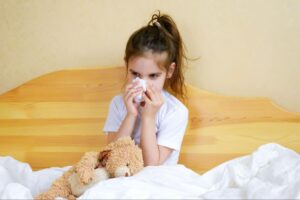
As parents, it’s natural to worry when your child falls ill, especially if you’re unsure whether the symptoms are mild or something more serious. From runny noses to stomachaches, most children will experience a variety of the most common childhood illnesses as they grow. While these illnesses are often a normal part of childhood development, understanding what they are, how to identify them, and when to seek medical help can provide peace of mind.
Many common childhood illnesses are mild and can be treated at home with basic care. However, it’s important to recognize the signs indicating when a pediatrician trip is needed. Early intervention can help prevent complications and ensure your child receives the appropriate treatment.
In this blog, we will explore some of the most frequently encountered childhood illnesses, including colds, fevers, stomach bugs, and others. You’ll learn how to identify the symptoms, what at-home remedies may help, and when it’s time to consult with your pediatrician. Understanding your child’s illness not only helps ease your worries but also empowers you to provide the best possible care and support during their recovery.
By familiarizing yourself with these common illnesses and staying up to date with the most current health guidelines, you can be better prepared to handle whatever comes your way, giving you confidence in managing your child’s health.
1. The Common Cold
What It Is: The common cold is one of the most frequent illnesses in children. Various viruses, most commonly rhinoviruses cause it. Colds are highly contagious and can spread easily, especially in group settings like daycare or school.
Symptoms:
- Runny or stuffy nose
- Sneezing
- Sore throat
- Cough
- Mild fever
- Fatigue
Treatment: While there is no cure for the common cold, symptoms can be managed with rest, hydration, and over-the-counter (OTC) medications like acetaminophen for fever or pain relief. A humidifier can also help ease congestion.
When to See a Doctor:
- If your child’s fever lasts more than a few days
- If your child is having difficulty breathing
- If symptoms worsen or persist beyond 10-14 days
2. Ear Infections
What It Is: Ear infections, or otitis media, are common in children, especially during cold and flu season. They occur when fluid builds up behind the eardrum, often as a result of a cold or upper respiratory infection.
Symptoms:
- Ear pain or tugging at the ear
- Difficulty hearing
- Irritability or fussiness
- Fever
- Trouble sleeping
Treatment: Most ear infections are viral and can resolve on their own. For bacterial infections, antibiotics may be prescribed. Pain relievers like acetaminophen or ibuprofen can help reduce discomfort.
When to See a Doctor:
- If your child experiences severe ear pain
- If the pain persists or comes and goes
- If there is fluid draining from the ear
- If your child is under 6 months old and has a fever
3. Strep Throat
What It Is: Strep throat is a bacterial infection caused by Streptococcus bacteria. It is highly contagious and spreads through respiratory droplets when an infected person coughs or sneezes.
Symptoms:
- Sore throat
- Pain while swallowing
- Fever
- Red spots on the roof of the mouth
- Swollen lymph nodes
- Headache or stomach pain (common in younger children)
Treatment: Strep throat requires a prescription for antibiotics to clear the infection and prevent complications such as rheumatic fever. It’s important to complete the full course of antibiotics even if symptoms improve.
When to See a Doctor:
- If your child has a sore throat with a fever
- If there are white patches or streaks of pus on the tonsils
- If your child complains of severe pain when swallowing
4. Chickenpox
What It Is: Chickenpox is a highly contagious viral infection caused by the varicella-zoster virus. Before the chickenpox vaccine became widely available, it was a common childhood illness. However, cases have declined significantly due to immunization.
Symptoms:
- Itchy red rash that begins on the face, chest, or back and spreads
- Fever
- Tiredness
- Loss of appetite
Treatment: Chickenpox usually resolves on its own within 5-10 days. You can alleviate symptoms by giving your child oatmeal baths, applying anti-itch creams, and using fever-reducing medications. It’s important to keep your child from scratching the rash to prevent infection.
When to See a Doctor:
- If the rash is severe or if your child develops a secondary skin infection
- If your child is younger than 1 year old or has a weakened immune system
5. Hand, Foot, and Mouth Disease (HFMD)
What It Is: Hand, foot, and mouth disease is a viral illness common in young children. It is caused by a group of viruses known as enteroviruses, most commonly coxsackievirus.
Symptoms:
- Fever
- Rash with red spots on the hands, feet, and sometimes the buttocks
- Mouth sores that may make swallowing painful
- Irritability
- Loss of appetite
Treatment: HFMD usually resolves on its own in 7-10 days. Symptom management involves providing plenty of fluids, offering soft foods, and using pain relievers to ease discomfort.
When to See a Doctor:
- If your child refuses to eat or drink and becomes dehydrated
- If the rash spreads to other parts of the body or becomes severe
6. Influenza (Flu)
What It Is: The flu is a contagious respiratory illness caused by influenza viruses. It can affect children of all ages, but those younger than 5 years old are at higher risk for complications.
Symptoms:
- High fever
- Cough
- Sore throat
- Muscle aches
- Fatigue
- Vomiting and diarrhea (more common in children)
Treatment: If caught early, antiviral medications can shorten the duration of the flu and reduce symptoms. Otherwise, treatment mainly focuses on relieving symptoms with fluids, rest, and fever reducers like acetaminophen or ibuprofen.
When to See a Doctor:
- If your child has trouble breathing or rapid breathing
- If symptoms worsen after initial improvement
- If your child has a chronic medical condition such as asthma or heart disease
7. Gastroenteritis (Stomach Bug)
What It Is: Gastroenteritis, commonly known as the stomach flu, is an infection that causes inflammation of the stomach and intestines. It is usually caused by viral infections like rotavirus or norovirus but can also be caused by bacteria.
Symptoms:
- Diarrhea
- Vomiting
- Stomach cramps
- Fever
Treatment: The best treatment for gastroenteritis is staying hydrated. Offer clear fluids like water, electrolyte solutions, and broths to prevent dehydration. In most cases, gastroenteritis resolves on its own within a few days.
When to See a Doctor:
- If your child is dehydrated (dry mouth, no tears, dark urine)
- If vomiting or diarrhea is severe or lasts more than 48 hours
- If your child has a high fever
8. Pink Eye (Conjunctivitis)
What It Is: Pink eye is an infection or irritation of the conjunctiva, the thin membrane that covers the white part of the eye. It can be caused by viruses, bacteria, allergies, or irritants like smoke or chemicals.
Symptoms:
- Redness or pinkness in the white part of the eye
- Itchy or burning eyes
- Discharge, which may be watery or thick and yellow
- Crusty eyelashes in the morning
Treatment: Viral pink eye typically resolves on its own in 7-10 days. Bacterial pink eye requires antibiotic eye drops or ointment. Allergic pink eye can be treated with antihistamine eye drops or oral antihistamines.
When to See a Doctor:
- If there is severe redness, pain, or sensitivity to light
- If the discharge becomes thick and yellow
- If symptoms don’t improve with over-the-counter remedies
9. Croup
What It Is: Croup is a viral infection that causes swelling of the airways, leading to a characteristic “barking” cough. It is most common in children between 6 months and 3 years of age.
Symptoms:
- Barking cough
- Stridor (a high-pitched sound when breathing in)
- Fever
- Hoarse voice
Treatment: Croup can be managed at home with a humidifier or by taking your child outside into the cool night air to ease breathing. If symptoms worsen, your doctor may prescribe steroids to reduce inflammation or provide nebulizer treatments.
When to See a Doctor:
- If your child is struggling to breathe
- If the cough gets worse, especially at night
- If your child’s lips or face turn blue
10. Respiratory Syncytial Virus (RSV)
What It Is: RSV is a common respiratory virus that affects children, especially infants and toddlers. It can cause symptoms similar to the common cold but can lead to more severe conditions like bronchiolitis or pneumonia.
Symptoms:
- Runny nose
- Coughing
- Wheezing
- Difficulty breathing
- Fever
Treatment: Mild cases of RSV can be managed with supportive care at home, such as rest and hydration. Severe cases may require hospitalization for oxygen therapy or other treatments.
When to See a Doctor:
- If your child has difficulty breathing
- If they are under 6 months old and showing symptoms of RSV
- If the fever is high and persistent
11. Rashes and Skin Infections
What It Is: Rashes are common in children and can be caused by a variety of factors, from allergic reactions to viral infections. Conditions like eczema, impetigo, or even contact dermatitis can cause rashes that may need attention.
Symptoms:
- Red, itchy patches of skin
- Blisters or sores
- Peeling or crusting skin
- Swelling or warmth in the affected area
Treatment: Treatment varies depending on the cause of the rash. For eczema, moisturizing creams and hydrocortisone may help. For impetigo, antibiotics are needed, and for allergic reactions, antihistamines or avoidance of the trigger can be effective.
When to See a Doctor:
- If the rash doesn’t go away or gets worse
- If blisters or sores become infected
- If your child has a fever or swollen lymph nodes along with the rash
12. Constipation
What It Is: Constipation is a common digestive issue in children, often caused by a lack of fiber in the diet, dehydration, or changes in routine. Most children experience constipation at some point in their lives, and it’s typically a temporary issue that can be managed with simple lifestyle changes.
Symptoms:
- Hard, dry stools
- Difficulty passing stools
- Abdominal pain or bloating
- Decreased appetite
Treatment: Increased fluid intake, a diet high in fiber, and regular physical activity can help relieve constipation. For severe cases, your pediatrician may recommend stool softeners or other treatments.
When to See a Doctor:
- If your child has persistent constipation that lasts for more than a week
- If your child has severe pain or cramping with bowel movements
- If there is blood in the stool
Conclusion: Caring for Your Child’s Health with Confidence
As a parent, it can be overwhelming to face the many illnesses your child may encounter. From the common cold to more serious conditions like pneumonia or RSV, it’s important to be prepared and know what to do when your child falls ill. Fortunately, most childhood illnesses are treatable and temporary, and understanding the symptoms and when to seek medical care can help alleviate your concerns.
While the majority of childhood illnesses can be managed with rest, hydration, and over-the-counter treatments, there are times when medical intervention is necessary. Knowing when to consult with your pediatrician can make all the difference in ensuring your child receives the appropriate care, whether it’s a prescription for antibiotics, a referral to a specialist, or advice on managing symptoms at home.
At HealthPark Pediatrics, we understand how stressful it can be when your child is unwell. Our experienced team of pediatricians is dedicated to providing compassionate, expert care to children of all ages. We’re here to guide you through every step of your child’s health journey—whether it’s answering questions about vaccinations, providing advice on treating a cold, or offering reassurance when more serious illnesses arise. Our goal is to give you the confidence and knowledge you need to care for your child’s health while ensuring they receive the best possible medical attention. We also strive to keep you up to date with the latest information and recommendations regarding your child’s health.
It’s important to remember that regular check-ups and preventative care are key to keeping your child healthy. Annual well-child visits help monitor growth and development, provide necessary immunizations, and offer an opportunity to discuss any concerns you may have about your child’s health. If your child is showing symptoms of a common illness or if you’re unsure whether a visit to the doctor is necessary, don’t hesitate to call us. We’re always ready to answer your questions, provide guidance, and schedule an appointment if needed.
Taking the time to understand the common illnesses your child may face and how to respond to them helps to reduce stress and ensures you’re equipped to handle whatever comes your way. Remember, it’s always better to err on the side of caution when it comes to your child’s health, and our team at HealthPark Pediatrics is here to support you every step of the way.
If your child is experiencing symptoms that concern you or if you simply have questions about their health, call us at HealthPark Pediatrics. We’re here to provide personalized care and ensure your child’s daily well-being.









